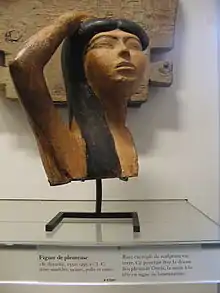陶瓦
陶瓦(Terracotta、Terra cotta 或 Terra-cotta,意大利文:「烤過的土」,[1]從拉丁語:而來),又稱粗陶、,是一種陶器,以粘土為原料,上釉或者是不上釉。[2] 器體本身為多孔設計。[3][4][5][6] 陶瓦被運用在許多器物上(最常被用在花瓶)、水道、屋瓦還有建築工程的外部裝飾,還有雕像如秦始皇兵馬俑。陶瓦同時也可以指運用這個材料所做成的物品,或者是陶瓦的原色(棕色),這個範圍相當大。在考古學與藝術史中,「陶瓦」通常指那些不是用陶工輪所製造的物品。
| 色 | ||
|---|---|---|
| 網頁顏色 | #B66655 | |
| RGBN | (r, g, b) | (182, 102, 85) |
| CMYKN | (c, m, y, k) | (0, 112, 136, 73) |
| HSV | (h, s, v) | (11°, 53%, 71%) |
| N:代表值域介於0~255之間 | ||
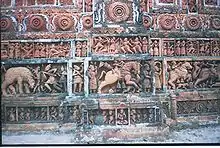
孟加拉Kantajew Temple外的陶瓦設計

北京紫禁城外的裝飾
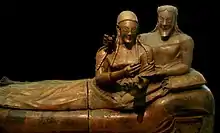
位於伊特魯里亞博物館的「夫妻的石棺」
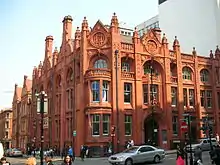
伯明罕的貝爾愛迪生大樓
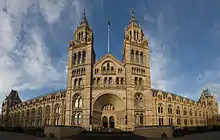
英國的自然歷史博物館的前廊有典型維多利亞時代建築的陶瓦裝飾
生產和特性
一個適當品質好的粘土被塑造為所需的形狀。乾燥後,它被放置在一個窯中然後燒製。典型的燒成溫度為1000℃,其中的鐵含量,使得燒結體呈現出黃色、橙色、紅色、粉紅色、灰色或褐色。燃燒過後的陶瓦並不防水,然而若在燃燒之前將表面拋光則可以減少表面的孔,此外,釉層可以使其防水。這適合作為在熱帶環境中的花園或建築的裝飾,以及耐油容器,油燈,或烤箱。 大多數其他用途,會運用在餐具,衛生下水道,而在寒冷的環境,這種器具需要上釉面。陶瓦如果無裂紋,輕輕地拍擊將會發出聲響。某些陶瓦是從回收的陶瓦中製造的。
參考
- Merriam-Webster.com
- OED, "Terracotta"
- ‘Diagnosis Of Terra-Cotta Glaze Spalling.’ S.E. Thomasen, C.L. Searls. Masonry: Materials, Design, Construction and Maintenance. ASTM STP 992 Philadelphia, USA, 1988. American Society for Testing & Materials.
- ‘Colour Degradation In A Terra Cotta Glaze’ H.J. Lee, W.M. Carty, J.Gill. Ceram.Eng.Sci.Proc. 21, No.2, 2000, p.45-58.
- ‘High-lead glaze compositions and alterations: example of byzantine tiles.’ A. Bouquillon. C. Pouthas. Euro Ceramics V. Pt.2. Trans Tech Publications, Switzerland,1997, p.1487-1490 Quote: “A collection of architectural Byzantine tiles in glazed terra cotta is stored and exhibited in the Art Object department of the Louvre Museum as well as in the Musee de la Ceramique de Sevres.”
- 'Industrial Ceramics.' F.Singer, S.S.Singer. Chapman & Hall. (*1971)Quote: "The lighter pieces that are glazed may also be termed 'terracotta.'
外部链接
| 维基共享资源中相关的多媒体资源:陶瓦 |
- Article on terracotta in Victorian and Edwardian Terracotta Buildings
- Bibliography,Smithsonian Institution,Ceramic Tiles and Architectural Terracotta
- Tile Heritage Foundation 页面存档备份,存于(US)
- Friends of Terra Cotta 页面存档备份,存于,non-profit foundation to promote education and preservation of architectural Terracotta
- Tiles and Architectural Ceramics Society 页面存档备份,存于(UK)
- La Terracotta(IT)
This article is issued from Wikipedia. The text is licensed under Creative Commons - Attribution - Sharealike. Additional terms may apply for the media files.
